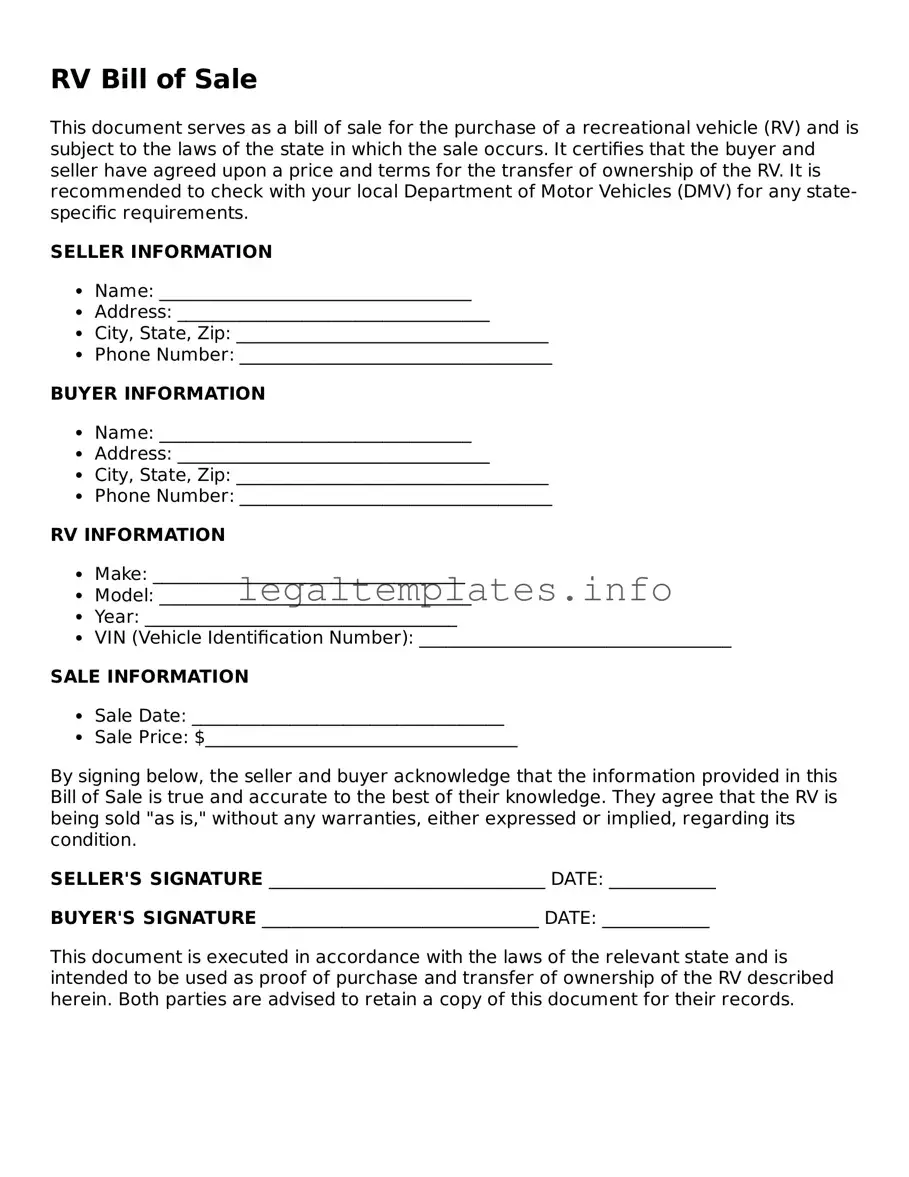What is a RV Bill of Sale form?
A RV Bill of Sale form is a legal document that records the sale and transfer of ownership of a recreational vehicle (RV) from one party, the seller, to another, the buyer. It essentially acts as proof of purchase and includes details such as the price of the vehicle, the date of the sale, and the names and signatures of both parties involved. This form also often lists specific information about the RV, like its make, model, year, VIN (Vehicle Identification Number), and odometer reading at the time of sale.
Why is a RV Bill of Sale form important?
The importance of a RV Bill of Sale form lies in its role as a critical piece of evidence for both the buyer and the seller. For the buyer, it is proof of ownership and can be used for registration, insurance, and tax purposes. For the seller, it is a record that they have legally transferred the rights of the RV to the buyer, absolving them from future liabilities related to the vehicle. Furthermore, this document can serve as a vital tool for settling disputes should any arise regarding the RV transaction.
What information is typically included in a RV Bill of Sale form?
In a typical RV Bill of Sale form, you would expect to find the seller's and buyer's full names and addresses, a description of the RV (including make, model, year, and VIN), the selling price, payment method (e.g., cash, check, or other), the sale date, and specific warranties or conditions of sale if any. Also included are spaces for the signatures of both the buyer and the seller, sometimes witnessed by a notary public to add authenticity to the document.
Do I need to notarize my RV Bill of Sale form?
Whether or not you need to notarize your RV Bill of Sale form often depends on state-specific requirements. In some states, notarization is necessary for the document to be considered legally binding or for use in registration. However, in other states, notarization may not be required. It's wise to check with your local Department of Motor Vehicles (DMV) or equivalent authority to understand the regulations in your area. Notarizing the document, regardless, adds a level of authenticity and could protect both parties in case of legal discrepancies.
Can I create a RV Bill of Sale form myself?
Yes, you can create a RV Bill of Sale form yourself as long as it includes all the necessary information required by your local laws for a vehicle sale. Many websites offer templates, but it's crucial to ensure that any template you use is compliant with your state's regulations. Alternatively, consulting with a legal professional can help ensure that the bill of sale meets all legal requirements, providing peace of mind and legal protection for both the buyer and seller.
What do I do with the RV Bill of Sale form after the sale?
After the sale, the buyer will need to submit the RV Bill of Sale form to their local DMV or equivalent authority as part of the registration process. The buyer should also keep a copy for their records and insurance purposes. The seller should retain a copy as well to have a record of the sale, proving the transfer of ownership and releasing them from future liabilities related to the RV. Keeping these documents in a safe place is advised as they can be crucial in the event of disputes, legal matters, or for reference in future transactions.
Is the RV Bill of Sale form the only document I need for selling or buying a RV?
No, the RV Bill of Sale form is not the only document you need when selling or buying an RV. While it is a critical component of the transaction, additional documents may be required for a complete and lawful transfer of ownership. Depending on your state, you might also need a clear title transfer, a release of lien if applicable, and compliance with any state-specific forms or disclosures. Check with your local DMV to ensure you have all necessary documents aligned with your state’s regulations. Proper preparation and knowledge of the needed documents can help make the sale process smoother for both parties involved.
